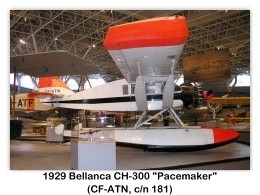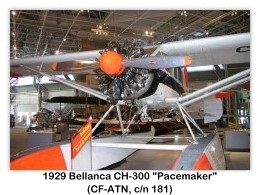
| ||||
|---|---|---|---|---|
 |
 |
 |
 |
 |



























| ||||
|---|---|---|---|---|
 |
 |
 |
 |
 |


























Bellanca CH-300 "Pacemaker"
United States — six-seat enclosed cabin monoplane
Archive Photos
Bellanca CH-300 "Pacemaker" (CF-ATN) at the Canada Aviation Museum, Ottawa, Ontario, Canada




Overview
The Bellanca CH-300 Pacemaker was a six-seat utility aircraft built primarily in the United States in the 1920s and 1930s. It was a development of the Bellanca CH-200 fitted with a more powerful engine and, like the CH-200, soon became renowned for its long-distance endurance.
Design and Development
Bellanca further developed the earlier CH-200 to create the CH-300 Pacemaker. The CH-300 was a conventional, high-wing braced monoplane with fixed tailwheel undercarriage. Like other Bellanca aircraft of the period, it featured flying struts. While the CH-200 was powered by 220-hp Wright J-5 engines, the CH-300 series Pacemakers were powered by 300-hp Wright J-6s. Late in the series some CH-300s were fitted with 420-hp Pratt & Whitney Wasps, leading to the CH-400 Skyrocket series.
Operational History
Pacemakers were renowned for their long-distance capabilities as well as reliability and weight-lifting attributes, which contributed to their successful operation throughout the world. In 1929, George Haldeman completed the first nonstop flight, New York to Cuba in 12 hours, 56 minutes, flying an early CH-300 (c. 1,310 miles, 101.3 mph). In 1931, a Bellanca fitted with a Packard DR-980 diesel, piloted by Walter Lees and Frederick Brossy, set a record for staying aloft for 84 hours and 33 minutes without being refueled. This record was not broken until 55 years later.
In Alaska and the Canadian bush, Bellancas were very popular. Canadian-operated Bellancas were initially imported from the United States, but later six were built by Canadian Vickers in Montreal and delivered to the RCAF (added to the first order of 29 made in 1929), which used them mainly for aerial photography.
Record Attempts
On June 3, 1932, Stanislaus F. Hausner flying a Bellanca CH Pacemaker named "Rose Marie" and powered by a 300-hp Wright J-6, attempted a transatlantic flight from Floyd Bennett Field, New York to Warsaw, Poland. The attempt failed when he made a forced landing at sea; he was rescued by a British tanker eight days later.
A CH-300 named "Lituanica" (NR688E) gained international fame when it was used by Steponas Darius and Stasys Girenas in an attempt to fly non-stop from the New York City to Kaunas, Lithuania. Departing on July 15, 1933, they spent 37 hours in the air before crashing in bad weather on the German-Polish border. A replica of Lituanica is in the Lithuanian Technical Museum while the wreckage of the original is at the Vytautas the Great War Museum.
Survivors
Hawaiian Airlines owns the world’s only CH-300 known to be in flying condition. The aircraft, which was acquired new in 1929 by Inter-Island Airways (which was renamed Hawaiian Airlines in 1941), was used for sightseeing flights over the island of Oahu for two years before being sold in 1933. Acquired from an aviation enthusiast in Oregon in early 2009, the aircraft was restored at the Port Townsend Aero Museum and was unveiled at the Honolulu International Airport on October 8, 2009.
One CH-300 "Pacemaker" is displayed at the Canada Aviation Museum (see above photos). This aircraft formerly served with Alaska Coastal Airlines. Another example is owned by the Virginia Aviation Museum, but this aircraft has been modified to CH-400 "Skyrocket" configuration and painted to resemble WB-2 Columbia, which made two pioneering transatlantic flights.
Variants
Bellanca CH-300 Specifications
General Characteristics
Weights
Power Plant
Performance
References